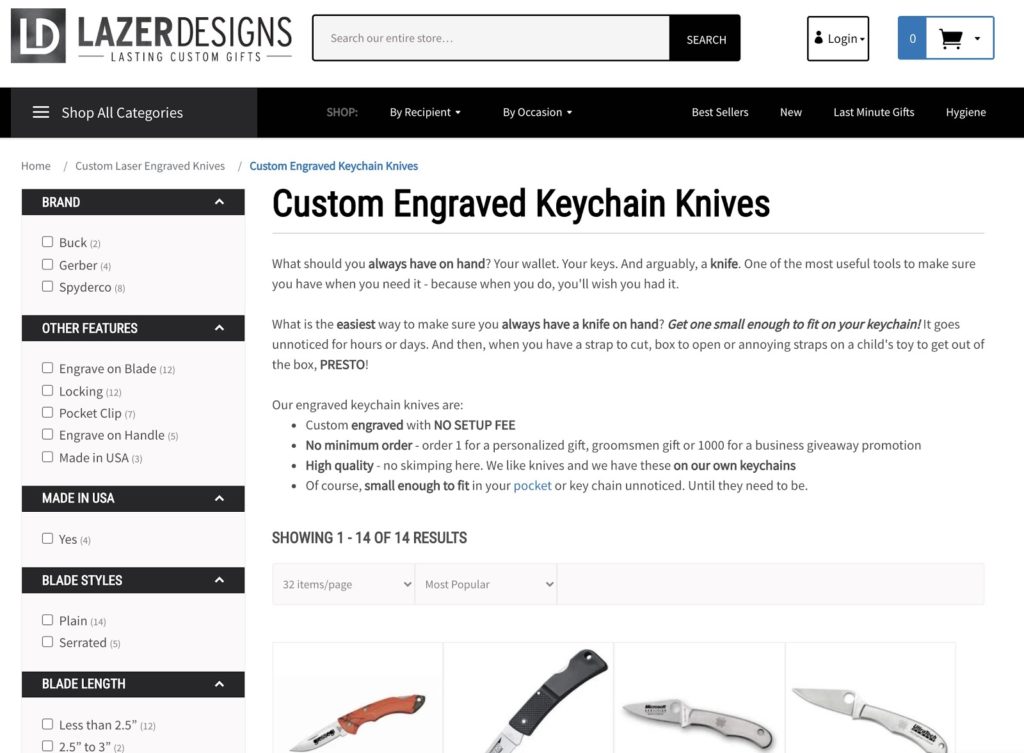Many ecommerce SEO experts recommend writing 1,000 to 2,500 word keyword-targeted blog articles to improve organic rankings and increase traffic. We’ve found that content quality matters more than word count, especially since Google relies on engagement metrics to determine the quality of your content.
Unfortunately, whether you write them in-house or hire an agency, high quality articles are time consuming and expensive to produce. Furthermore, you need a lot of them to achieve significant keyword expansion.
In our work, we are always looking to strike the right balance between content quality and content quantity. Sometimes, it makes sense to invest heavily in long form content to rank for a specific competitive keyword. Sometimes, shorter content is sufficient to rank for a mid-funnel, longtail keyword. You’ll need to do some research in your product category to understand the trade-offs and find the right balance.
In this article, we discuss alternatives to article writing and blogging for creating keyword targeted content to increase your content creation and organic sales.
The Problem with Article Writing
Too many marketers are stuck in the mindset that blogging is the only way to create keyword targeted content. The problem is: developing content is time-consuming and you need a lot of it to significantly scale up your organic traffic.
Typically, a freelance writer can produce 1 or 2 articles per week. When you need more articles per week, you hire more writers (we hired 20 freelance writers for one large project).
Managing more than one writer can be time consuming and frustrating if the writers need hand holding. And your only reward is the occasional article that ranks well and generates traffic. Many articles perform poorly or turn out to be completely worthless.
More Content at the Same Cost
Working with a writer on an article typically involves researching keywords, developing an outline and a couple rounds of revisions. In the best case, this process takes a week and results in an article that ranks for the intended keywords.
BUT, what if the writer could have written copy for 25 pages in the same amount of time?
Using the same writer to write copy for pages that only need a few sentences of copy (or at most 250 words of copy) would be 20x more efficient. You would get 20-30 pages of content per week instead of just 1 or 2.
This is why we focus on creating product collection pages, sparse product pieces and Q&A content. These content types allow us to target more keywords more quickly.
What’s the Catch?
Speeding up your content creation by a factor of 10 for the same cost sounds too good to be true.
Here’s the catch: The efficient content types we recommend don’t work for highly competitive keywords. But, they can work for everything else. We use the efficient content approach for mid-funnel and long tail keywords.
For example, in the gifting category, keywords like “non-alcoholic groomsmen gifts” or “mother’s day gifts for mother in law” can be targeted with efficient content types.
Ranking for super competitive keywords like “winter tires” or “iphone cases” would require a different strategy, perhaps long-form content that attracts backlinks.
Content Quality Matters
Choosing the right type of content for your keyword strategy is like Goldilocks picking the perfect bowl of porridge. You’ve got to choose content that is not too expensive to create and not too low quality to rank.
For mid-funnel and long tail ecommerce keywords, the sweet spot is often useful content with a low word count that satisfies the searcher’s query.
For example: for the keyword “custom engraved keychain knives” LazerDesigns.com created a useful page with only 162 words of content and a product grid.

Measuring Content Quality
There is a strong connection between content quality and rankings. But, it’s important to understand that rankings are a relative game and how Google measures content quality.
We don’t know the exact factors that Google uses to rank a page, but we do know that rankings are relative – i.e. your content doesn’t need to be perfect, it just needs to be better than the competition for a given keyword. For long tail, mid-funnel keywords the bar isn’t as high as it is for the most competitive keywords.
Also, Google measures engagement signals to determine if a page is useful to people who search for a specific keyword. These engagement signals are metrics similar to “Bounce Rate” and “Time on Page” you see in Google Analytics.
This means that short-form content that is useful and drives engagement will rank better than long form content that is not very useful to searchers.
Content Efficiency
Writing resources are always limited, even for brands with large budgets. So, focus on content efficiency — i.e. the number of pages your writer can create in a week. If you are only getting one article per week out of each writer then organic growth will be constrained accordingly.
What if each writer could create 20 or 30 pages of content per week? If each page targets a relevant keyword, you’ve dramatically improved your keyword expansion efforts. This level of content efficiency is possible when you focus on efficient content types.
Efficient Content Types
Here are the types of efficient content we’ve created with good results.
- Collection pages – This content type can rank well for mid-funnel keywords. You will need to choose keywords with the appropriate level of competition and search volume, then write a few sentences of copy and choose products for the grid. Here is an example. Our writer can write the copy for 10 or 20 of these pages in an hour.
- Q&A content – Answering specific questions related to your products in your category will attract traffic if you choose your keywords wisely. Here is an example. Our writer can write 5 -10 FAQ answers in an hour.
- Sparse product articles – These articles are heavy on images (usually lifestyle shots) and sparse on copy (250 words or less). They can target keywords like “what to wear on a european vacation” and feature product links to drive conversions. Here is an example. Our writers can write two or three of these articles in an hour.
Takeaways
SEO has long been a content game. Most ecommerce managers spend a great deal of time creating optimized product pages, collection pages and blog articles.
However, there is no way to accurately predict rankings and traffic for a page before it’s published. Some pages on your site will rank well. Other pages won’t attract any organic traffic despite your best efforts.
You’ll need to increase your chances of winning the rankings lottery by creating as much keyword targeted content as you can. To massively increase your content creation, we recommend focusing on short-form content that is useful to searchers and targets high value keywords.

